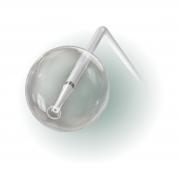WARNING:
• CAUTION: Do not exceed the rated volume of 1cc for the 611200 - 9.5mm Catheter. Over inflation may cause balloon rupture.
• CAUTION: Do not exceed the rated volume of 2cc for the 611100 - 13.5mm Catheter Over inflation may cause balloon rupture.
• Use only appropriate balloon inflation medium. Do not use air or gaseous medium to inflate the balloon.
• Use only a 3cc inflation device with pressure gauge for inflation.
• Use a 3cc inflation device with pressure gauge for deflation. (For faster deflation, up to a 10cc inflation device with pressure gauge may be used).
• Do not exceed an injection pressure of 300 psi for the 611200 - 9.5mm Catheter.
• Do not exceed an injection pressure of 600 psi for the 611100 - 13.5mm Catheter.
• Do not advance the guidewire, septostomy catheter, or any other component if resistance is met, without first determining the cause and taking remedial action.
• This catheter is not recommended for pressure measurement or fluid injection.
• This device is intended for single use only. Do not resterilize and/or reuse it, as this can potentially result in compromised device performance and increased risk of cross contamination.
• The use of excessive force to pull the balloon across the atrial septum must be avoided.
PRECAUTIONS:
• B. Braun Interventional Systems Inc. recommends the 611200 - 9.5mm catheter be used with a 5F introducer to insure admittance.
• B. Braun Interventional Systems Inc. recommends the 611100 - 13.5mm catheter be used with a 6F introducer to insure admittance.
• Balloon atrioseptostomy should not be performed for infants older than six weeks. These infants will have thick atrial septums. Reference AHA/ACC guidelines.
• Dilatation procedures should be conducted under fluoroscopic guidance with appropriate x-ray equipment.
• Guidewires are delicate instruments. Care should be exercised while handling to help prevent the possibility of breakage.
• Careful attention must be paid to the maintenance of tight catheter connections and by aspiration before proceeding to avoid air introduction into the system.
• Under no circumstances should any portion of the catheter system be advanced against resistance. The cause of the resistance should be identified with fluoroscopy and action taken to remedy the problem.
• If resistance is felt upon removal, then the balloon, guidewire and the sheath should be removed together as a unit, particularly if balloon rupture or leakage is known or suspected. This may be accomplished by firmly grasping the balloon catheter and sheath as a unit and withdrawing both together, using a gentle twisting motion combined with traction.
• Before removing the catheter from the sheath it is very important that the balloon is completely deflated.
• Proper functioning of the catheter depends on its integrity. Care should be used when handling the catheter. Damage may result from kinking, stretching, or forceful wiping of the catheter.

.jpg)

.jpg)